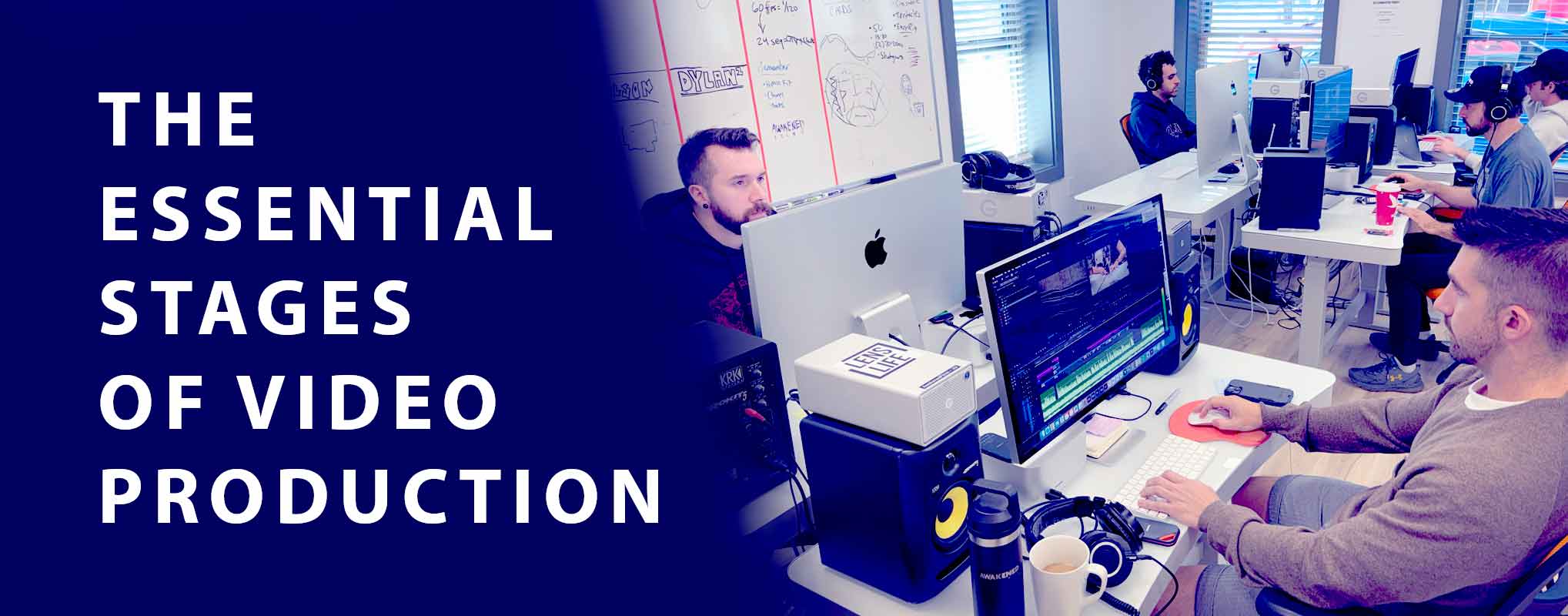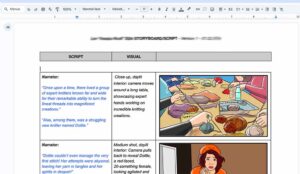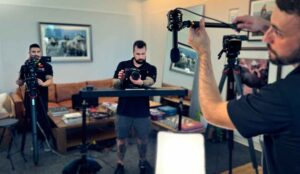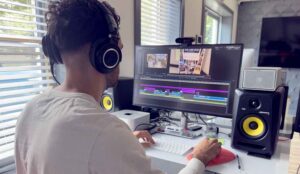
Frame by Frame
The Art and Science of Stellar Storytelling

By Jason Schuler on July 15, 2025

A lot of blogs and articles on the interwebs will tell you that producing a video has three distinct stages: pre-production, production, and post-production. Sure, that’s technically true. But if you really want to understand all of the essential elements that make a video production successful, read on to learn about all five stages of video production.
At Awakened Films, we’ve produced everything from Public Service Announcements to national viral campaigns. Over time, we’ve learned that the real process doesn’t start when the cameras roll. And it doesn’t end when the file is exported. There’s a lot more to producing an award-winning video, and if you’re looking for video production services in New Jersey, you deserve to get all that you’re paying for.
 1. Concept Development
1. Concept DevelopmentOf course there is a step before pre-pro! Before there’s a script, there’s a spark. When our clients say, “We need a video” they don’t actually mean “We need help crafting a story that resonates so powerfully with our target audience that they will react in this specific way!”.
Ideation is where the production journey begins. What’s the message? Who’s it for? What should they do after watching? These aren’t creative questions. They’re strategic ones. If you get this part wrong, no camera in the world can save the project.
We collaborated with a school district in Bergen County on a video designed to support teacher recruitment. But the real issue wasn’t headcount. It was public perception. That discovery changed everything. The final video focused on teacher impact, not job listing info. Applications went up within a week of release.
Tip: Don’t start with a script. Start with a goal. Write it down in one sentence. If it’s not clear, neither will your video be.
AI Integration: AI tools can help organize thoughts, test taglines, or rough out messaging. Just don’t let them lead the story. LLMs like ChatGPT were designed to say yes to anything you input. Your brand needs a human voice.
 2. Pre-Production
2. Pre-ProductionThis is where most problems are either solved or ignored.
In pre-production, the idea becomes a plan. That includes scripts, schedules, budgets, locations, crew, casting, and approvals. This is also where you lock in your creative approach and get buy-in from all sides.
If you’re working with a team that cuts corners here, you’re going to feel it later. Pre-pro is the seedling from which grows a calm & productive shoot. It’s where the creative director downloads all initiatives and ideas. It’s where the production team troubleshoots the application of these creative directives, writing up a detailed plan of execution. And if the pre-production is done right, the editor knows what to expect before opening a single clip.
We recently worked on a project in Newark/Hillside for a logistics company. The client didn’t realize they needed Spanish and English versions until well into the pre-production phase. Luckily, our planning docs flagged it early. During casting, we intentionally included bilingual talent and blocked out extra time in the schedule for alternate takes.
Tip: Put one person in charge of approvals. Too many voices in the review process will slow everything down or lead to conflicting feedback.
AI Integration: Location matching, scheduling tools, and budgeting calculators can save hours. New storyboard tools, such as Storyboarder.ai, make the vision and planning process even more efficient. Use AI tools to move faster, but double-check every result.
 3. Production
3. ProductionThis is the shoot itself. It’s the phase most people imagine when they think about “video production.” Lights, cameras, cables, coffee (and quiet on set).
If your pre-pro was solid, production should feel smooth. Everyone knows where to be and what to do. There’s room for creativity, but not chaos. The ideal shoot day has a strict schedule for principal photography, and also opportunities to experiment with the talent / messaging / visuals.
For a recent shoot in Morristown, we had just four hours in a medical facility before the space reopened to patients. Because of our prep, we walked in with a clear plan. We got everything we needed, wrapped early, and didn’t interrupt a single appointment.
Tip: Protect your message. Someone will always suggest “just one more shot.” Don’t chase extra footage if it doesn’t serve the goal.
AI Integration: Smart teleprompters, live transcription apps, and camera tracking tools can make shoots more efficient. Just keep the tech from slowing you down. Speed matters.

Post is where the story takes shape. This is where your editor brings the footage to life.
The process usually includes video editing, music, motion graphics, color correction, voiceover, and sound mixing. This is also where pacing, emotion, and tone get baked in.
Our clients typically scope for two sets of revisions. This is sufficient to incorporate input from major stakeholders, while maintaining a post-process that is efficient and cost-effective.
We were recently in post on a large series of comedic commercials for a national chemical manufacturing company in Northern New Jersey, and the client decided to invest in an all-day on-location edit session at our Madison based studio. The space is clean, modern and private which allowed our client to focus on getting through all 18 sets of revisions in one day.
Tip: Give clear notes. Be specific about what you want changed and why. Always collect ALL revisions from all stakeholders into a single set and review internally before submitting for re-edits. And don’t be afraid to utilize traditional tools like time code burns to synchronize the post process between departments.
AI Integration: As of my writing in the summer of 2025, AI is a little too novel to generate full post-production decisions on its own. Tools like Capcut and Adobe Sensei can auto-tag, rough cut, and even suggest graphics & music. They’re fast, but not final. Trust your editor’s instinct more than the algorithm.

A video sitting on your desktop isn’t doing anyone any good.
Distribution is about viewing different marketing strategies. Where will the video live? Who needs to see it? Should there be different versions for different platforms? What do those platforms prefer in terms of running time and canvas size/shape? Ask yourself, how could the right headline, description and thumbnail help reach the right target audience (and increase SEO/GEO)…
We often create vertical re-edits for social, adding captions for accessibility, and, prepare custom cuts for events, landing pages, and internal use. Ideally, this should all be decided before the shoot, not after. But a good production company in NJ will accommodate scope changes throughout the video production process.
One client in Central Jersey had us shoot a 90-second overview, plus six 15-second social cuts and a 30-second paid placement connected TV spot…All from the same footage! Sounds like a monster project, but because we planned it upfront, it was seamless, and they didn’t pay a dime extra for additional shoots. That’s smart distribution.
Tip: Know your channels early. If you need an Instagram cut, you should shoot it differently than a website banner. Framing matters.
AI Integration: Auto-cropping, social cut generators, and even A/B testing can help improve reach. It may be possible to use AI here to stretch your budget and speed up delivery. Tools such as TubeBuddy can help with the SEO side of headlines & descriptions.
Here is a video about the process we use at Awakened Films, to help our clients get from ideation to distribution:
FAQ: What are the 5 stages of video production?
Most people talk about three stages: pre-production, production, and post. But in practice, it’s more like five. At Awakened Films, we break it down as:
Each step plays a different role in shaping a video that actually works for both the brand and the audience.
FAQ: How long does the video production process take?
It depends on the scope. A simple talking-head video might take 2–3 weeks. A story-driven piece with scripting, interviews & b-roll (or actors) and motion graphics can take 6–10 weeks from concept to final delivery. We’ve turned around some rush jobs in a few days, but the best results come when the schedule allows time for strategy and feedback.
FAQ: What happens during pre-production?
Pre-production is where the planning happens. That includes writing scripts, scheduling shoots, casting talent, booking locations, and coordinating logistics. It’s also where we align on tone, goals, and messaging—because if we don’t nail that up front, we’re guessing later.
FAQ: What makes a good production day?
A smooth production day doesn’t feel hectic. It feels focused. The crew is prepared, the schedule makes sense, and everyone knows what success looks like. That doesn’t happen by accident. It’s the result of smart pre-production and clear communication.
FAQ: Can AI help with the stages of video production?
Yes, but it has limits. We use AI for tasks like rough cutting, transcription, versioning, and shot planning. It’s great for saving time. But when it comes to shaping story, pacing, and emotional tone, human instinct still leads.
FAQ: What’s the most overlooked part of video production?
Distribution. Too many people stop at “final cut” and call it done. But if your video isn’t seen, you’re wasting potential. We help our clients think about distribution from day one, ie; what formatting is needed for which platforms, on-page SEO for video landing pages, the power of a good thumbnail, the best title/description for YouTube vs TikTok vs Instagram vs LinkedIn. You’ve put in the majority of the work getting to this point, let’s finish strong!
FAQ: What kind of video content do you produce in NJ?
We’ve created fundraising videos, brand films, product explainers, recruitment videos, social media content, and short-form docs. Most of our work blends strategy and story. If it needs to connect emotionally and look great, that’s where we shine.
FAQ: Do you work with clients outside of New Jersey?
Yes, some brands must use the absolute best vendors, no matter the geographic distance. But most of our clients are based in New Jersey and the tri-state area. We’re often on location in places like Morristown, Princeton, Jersey City, and NYC.
Awakened Films helps clients across New Jersey and the tri-state area create story-driven content with clarity, creativity, and purpose. From ideation to final distribution, we don’t just film; we help you figure out what’s worth saying (and how to say it).
Let’s talk. We’d love to help you bring your message to life.
Looking for more options? Check out our July 2025 listicle dedicated to the best commercial production companies in New Jersey.